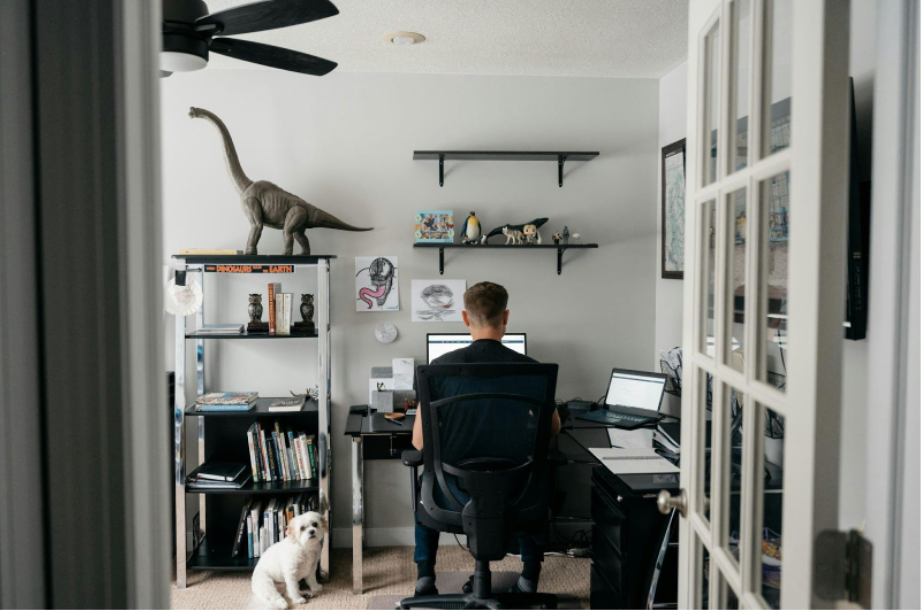Image from Unsplash
The modern home office is no longer just a desk in the corner, it’s the control center for our professional lives, creative projects, and, increasingly, our mental wellbeing. Many people are realizing that a workspace isn’t just about where you work; it’s about how you feel while you work. Whether you’re tackling client projects, managing a small business, or juggling multiple roles, your environment shapes your performance. For some, that means investing in ergonomic furniture, better lighting, and small rituals, like taking a mid-afternoon pause with Medterra, that help keep stress at bay and energy levels steady.
The Link Between Environment and Output
Our surroundings influence our mood, focus, and even decision-making ability. Psychologists have long recognized the “environment-behavior” link, cluttered, dimly lit spaces can cause mental fatigue, while organized, well-lit rooms promote clarity and alertness.
Working from home amplifies this connection. Without the natural boundaries of a commute or office setting, your workspace can easily blur into your personal life, creating subtle but significant stress.
Creating a harmonious home office means designing a space that works with you, not against you. This involves paying attention to physical comfort, mental stimulation, and emotional cues that signal “you’re in the zone.”
Ergonomics: Your First Line of Defense
Aches, strains, and fatigue can quietly erode your productivity. That’s why ergonomics, the science of designing workspaces to fit the user, is foundational.
- Chair & Desk Setup: Your chair should support your lower back, and your desk height should allow elbows to rest at about a 90-degree angle.
- Screen Position: The top of your monitor should be at or slightly below eye level, about an arm’s length away.
- Movement Breaks: Stand, stretch, and walk regularly to reduce stiffness and improve circulation.
The Health and Safety Executive (HSE) offers excellent guidelines on home workstation setups to minimize discomfort and long-term injury risks.
Lighting: More Than Just Brightness
Lighting impacts both your energy and your mood. Natural light boosts serotonin and helps regulate your circadian rhythm, which can improve sleep quality and focus.
If possible, position your desk near a window. When natural light isn’t an option, opt for full-spectrum bulbs that mimic daylight. Warm-toned task lighting can also make your workspace feel more inviting and reduce eye strain during evening hours.
Declutter for Mental Clarity
Clutter competes for your attention, even if you don’t realize it. A messy desk can make it harder to focus and more stressful to switch between tasks.
Consider a weekly declutter session. Keep only what you need on your desk, laptop, notebook, essential stationery, and store everything else out of sight. Minimalist doesn’t have to mean sterile; you can add warmth with personal touches like a small plant or framed photo.
Soundscaping Your Space
Noise affects cognitive performance, but total silence can feel isolating. The sweet spot often lies in controlled background sounds.
Some people focus best with instrumental music or nature sounds, while others prefer low-volume ambient noise like a café soundtrack. Experiment with playlists or apps to see what keeps you engaged without distraction.
If outside noise is an issue, noise-cancelling headphones can be a worthwhile investment.
The Psychology of Color
Colors can subtly influence your state of mind:
- Blue and Green: Promote calm and focus.
- Yellow: Encourages optimism and creativity.
- Neutrals: Provide a balanced backdrop that reduces visual fatigue.
You don’t have to repaint your entire office, small accents like cushions, art, or desk accessories can shift the mood of the space.
Balancing Productivity and Wellbeing
Image from Unsplash
A high-functioning workspace isn’t about working more, it’s about working better. That means building in small habits that protect your mental health:
- Scheduled Breaks: Treat them as non-negotiable appointments.
- Movement Rituals: Stretch or walk to reset your energy.
- Sensory Pauses: Enjoy a favorite tea, a few minutes of deep breathing, or a small treat that signals it’s time to recharge.
Some professionals keep a “transition ritual” at the start and end of the day, like lighting a candle, journaling, or tidying the desk. This signals to your brain when it’s time to switch modes.
Integrating Wellness into Your Workday
Wellbeing shouldn’t be an afterthought, it’s part of sustained productivity. The self-employed, remote workers, and entrepreneurs often blur the line between work and personal time, making intentional wellness practices even more important.
Think of wellness as a toolkit you can access throughout the day:
- A few minutes of mindful breathing before big meetings
- A comfortable chair that supports good posture
- A mid-day snack that fuels without crashing your energy
- A calming ritual in the evening to mark the end of the workday
These are small, cumulative investments in your mental and physical resilience.
The Role of Ritual in a Remote Setting
Working from home removes a lot of external structure, so creating internal structure becomes key. Rituals, consistent actions tied to specific times or cues, help reinforce focus and balance.
For example:
- Starting the day with a specific playlist or scent
- Ending the day by closing your laptop and turning off your desk lamp
- Taking an afternoon break at the same time daily
These rituals create mental bookends that protect against burnout and help you transition smoothly between work and home life.
Plants, Art, and the Human Touch
Biophilic design, the integration of nature into interior spaces, has been shown to reduce stress and increase creativity. Even one or two plants can improve air quality and add visual interest to your workspace.
Art can also boost mood and motivation. Choose pieces that inspire you, whether it’s abstract shapes, landscapes, or personal photographs. Your workspace should reflect your personality, not just your job description.
Making Your Office Work for You
A workspace should adapt to your needs, not the other way around. That might mean reconfiguring your desk layout every few months, swapping your chair for a standing desk, or changing your lighting as seasons shift.
Think of your home office as a living space, dynamic, evolving, and responsive to your personal workflow.
A harmonious home office blends physical comfort, mental clarity, and emotional wellbeing into one functional environment. By fine-tuning elements like ergonomics, lighting, sound, and personal touches, you create a space that supports both your professional output and your peace of mind.
The goal isn’t just to have a place to work, it’s to have a place where you work well. In the end, the most productive workspace is one that helps you thrive, not just survive, through your workday.

















